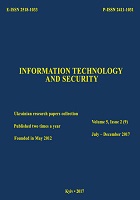Architecture of software based on integrated objects
DOI:
https://doi.org/10.20535/2411-1031.2017.5.2.136959Keywords:
Software architecture, integrated objects, valence of objects, formula of connection, isomer classes.Abstract
The paper presents an architecture of software consisting of objects capable of direct interaction by the formation of active dynamic connections, which can be atomic or integral objects. It has been determined that any combination of objects, like atoms, has valency- the ability to form connections, and can be encapsulated into a class of connection. The principles on which the proposed architecture is based are formulated, such as the existence of an atomic basis on architecture, the encapsulation of connectors in components, integration as the basic principle of constructing a component hierarchy, the prohibition of inheritance of component classes at the atomic and higher levels, and the descriptiveness of component structures. It is shown that the formation of new derivative classes in the form of atomic connections can be considered an integration, whose degree depends on the level of integration of the constituent objects. The hierarchy of classes on the basis of integration without inheritance allows using a unified mechanism for both class creation and interaction of objects. As a result of the research, a universal mechanism for constructing integrated objects was developed through a descriptor that contains a complete description of the structure of the object, that allows to use the universal function of synthesizing the connections of all integral objects. It is substantiated that the resolving of any task can be considered as a process of synthesis of a descriptor of an integrated object. The questions of static and dynamic behavior of integrated objects are considered, a two-stage approach to the creation of an integral object was developed by creating an initial proto-object with the subsequent construction of a complete object, which enables the delayed and partial creation of an integrated object when used in the program. It is determined that during program execution the structure of an integrated object is functionally equivalent to the complete disintegrated of an object to an atomic level, which allows to explicitly transform integral objects into atomic connections. Isomeric classes of objects are considered which can change the structure of the connection at run time, leaving the external interface unchanged. As a description of the architecture, a graphic form, a formula of connection that reflects the composition of the integral object and the degree of integration, an atomic formula of connection that reflects the actual structure of the integrated object from the atoms, and a structural formula that reflects the order of connecting objects in the connection are selected. It is shown that for such architecture it is possible to apply operations over configuration both statically and dynamically.
References
S.V. Bevz, А.G. Grechko, and S.Y. Vyshnevs’kyi, “Study of implementation design patterns in software development”, Proc. Vinnytsya national technical university, No 4, pp. 208-210, 2013.
А.Е. Doroshenko, and V.А. Iovchev, “Tools for designing object-oriented programs based on algebra of algorithms”, Problems of programming, No 2-3. pp. 241-250, 2012.
O.Y. Kovalenko, “Standardization of the formal description of the system architecture of situational centers”, in Proc. XI Scientific and Practical Conference of Decision Support Systems, Kyiv, 2015, pp. 111-114.
V.M. Medvedeva, “Integration of the means of an aspect-oriented approach in object-oriented programming language”, East European Magazine of Advanced Technology, No 2 (2), pp.19-28, 2016.
М.Т. Fisun, “The software model based on the integration of modular, layered, and object-oriented architectures”, in Proc. Black Sea State University named after Petro Mohyla, vol. 90, No 77, pp. 205-215, 2008.
V. Sokolov, “Programming technology of active dynamic connections ofobjects” in Proc. V scientific conference Priority directions of development of telecommunication systems and networks for special purposes, Kyiv, 2010, p. 232.
V. Sokolov, “Application of functional and relational models in object-oriented programming”, Information Technology and Security, Vol. 5, Iss. 1, pp. 54-63, January-June 2017.
Downloads
Published
How to Cite
Issue
Section
License
Copyright (c) 2020 Collection "Information technology and security"

This work is licensed under a Creative Commons Attribution 4.0 International License.
The authors that are published in this collection, agree to the following terms:
- The authors reserve the right to authorship of their work and pass the collection right of first publication this work is licensed under the Creative Commons Attribution License, which allows others to freely distribute the published work with the obligatory reference to the authors of the original work and the first publication of the work in this collection.
- The authors have the right to conclude an agreement on exclusive distribution of the work in the form in which it was published this anthology (for example, to place the work in a digital repository institution or to publish in the structure of the monograph), provided that references to the first publication of the work in this collection.
- Policy of the journal allows and encourages the placement of authors on the Internet (for example, in storage facilities or on personal web sites) the manuscript of the work, prior to the submission of the manuscript to the editor, and during its editorial processing, as it contributes to productive scientific discussion and positive effect on the efficiency and dynamics of citations of published work (see The Effect of Open Access).

